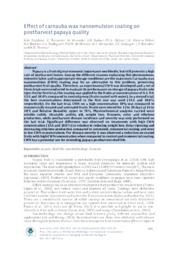Effect of carnauba wax nanoemulsion coating on postharvest papaya quality.
Effect of carnauba wax nanoemulsion coating on postharvest papaya quality.
Author(s): ZUCCHINI, N. M.; FLORENCIO, C.; MIRANDA, M.; OLDONI, F. C. A.; BONFIM, N. S.; RODRIGUES, K. A.; OLIVEIRA, R. M. D. DE; FOSCHINI, M. M.; HUBINGER, S. Z.; BRESOLIN, J. D.; FERREIRA, M. D.
Summary: ABSTRACT: Papaya is a fruit of great economic importance worldwide, but still presents a high rate of postharvest losses. Among the different reasons explaining this phenomenom, intensive labor and inappropriate storage conditions are the main ones. Carnauba wax nanoemulsion (CWN) coating may be an alternative to this problem, preserving postharvest fruit quality. Therefore, an experimental CWN was developed and a set of three trials were conducted to evaluate its performance on storage of papaya fruits solo type. On the first trial, this coating was applied to the fruits at concentrations of 4.5, 9.0, 13.5 and 18.0% compared to control group (fruits coated with water). In a second trial, the best concentrations determined in the first one was used (13.5 and 18.0% respectively). On the last trial, CWN on a high concentration 18% was compared to commercially treated and untreated fruits. Fruits were stored for 12 to 20 days at 16 to 18°C and Relative Humidity upper to 70%. Physicochemical analyzes carried were soluble solids, titratable acidity, pH, weight loss, firmness, color and ethylene production, while postharvest disease incidence and severity was only performed on the last trial. Significant difference was observed on treatments with high CWN concentration (13.5 and 18.0%) in relation to reducing weight loss, delay ripening and decreasing ethylene production compared to untreated, commercial coating and even to low CWN concentrations. For disease severity it was observed a reduction on coated fruits with high CWN concentration when compared to control and commercial coating. CWN has a potential use for extending papaya postharvest shelf life.
Publication year: 2021
Types of publication: Journal article
Unit: Embrapa Instrumentation
Keywords: Diseases, Nanotechnology, Papaya, Shelf life
Observation
Some of Embrapa's publications are published as ePub files. To read them, use or download one of the following free software options to your computer or mobile device. Android: Google Play Books; IOS: iBooks; Windows and Linux: Calibre.
Access other publications
Access the Agricultural Research Database (BDPA) to consult Embrapa's full library collection and records.
Visit Embrapa Bookstore to purchase books and other publications sold by Embrapa.

